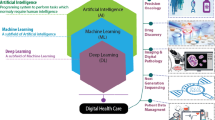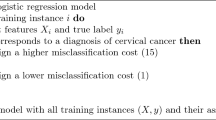Abstract
Currently, the computational disease diagnostic models are mainly for approximating the non-linear complex sensitive patterns in the medical data. For the most accurate diagnostic, it is to be processed by more sophisticated algorithms. The clinical data is obtained from various clinical tests conducted on both infected and healthy individuals. It is crucial to precisely identify the presence of sickness to provide treatment promptly. Disease detection models must accurately differentiate between true positive and negative outcomes. Manual interpretations may result in either false positives or false negatives. This study aims to create a universal framework for diagnosing diseases on clinical datasets. For this scenario, the Extreme Learning Machine (ELM) is combined with the Bacterial Colony Optimization (BCO) method to boost prediction accuracy and speed up global convergence. For efficient selection of the extreme learning machine model’s optimal weights and biases, it is recommended to use the BCO algorithm's neighborhood-based communication strategy. Eight different UCI medical datasets are used to analyze the performance of the developed optimized ELM method. The experimental results showed that the suggested BCO-ELM outperformed in terms of accuracy, sensitivity, specificity, precision, f-measure, ROC-AUC, convergence speed. It obtained approximately 5 to 10 percent maximal accuracy and f-measure than the existing traditional approaches and obtained an AUC of 0.9 to 1 on all datasets. The experimental results confirmed that the developed approach produced high classification accuracy when compared with other existing approaches.

































Similar content being viewed by others
Data Availability
The used datasets are available in https://archive.ics.uci.edu/. WBDC: https://archive.ics.uci.edu/dataset/17/breast+cancer + wisconsin + diagnostic. WBPC: https://archive.ics.uci.edu/dataset/16/breast+cancer + wisconsin + prognostic. Thyroid: https://archive.ics.uci.edu/dataset/102/thyroid+disease. Heart Disease: https://archive.ics.uci.edu/dataset/45/heart+disease. Parkinson’s Disease Classification: https://archive.ics.uci.edu/dataset/470/parkinson+s+disease + classification. Fertility: https://archive.ics.uci.edu/dataset/244/fertility. MD: https://archive.ics.uci.edu/dataset/351/mesothelioma+s+disease + data + set. CC: https://archive.ics.uci.edu/dataset/537/cervical+cancer+behavior+risk.
References
Kumari N, Acharjya D. Data classification using rough set and bioinspired computing in healthcare applications-an extensive review. Multimed Tools Appl. 2023;82(9):13479–505.
Pawlovsky AP. An ensemble based on distances for a kNN method for heart disease diagnosis. In 2018 international conference on electronics, information, and communication (ICEIC). 2018. IEEE.
Ilyas H, et al. Chronic kidney disease diagnosis using decision tree algorithms. BMC Nephrol. 2021;22(1):1–11.
Asadi S, Roshan S, Kattan MW. Random forest swarm optimization-based for heart diseases diagnosis. J Biomed Inform. 2021;115: 103690.
Bhagya Shree S, Sheshadri H. Diagnosis of Alzheimer’s disease using naive Bayesian classifier. Neural Comput Appl. 2018;29:123–32.
Dolatabadi AD, Khadem SEZ, Asl BM. Automated diagnosis of coronary artery disease (CAD) patients using optimized SVM. Comput Methods Programs Biomed. 2017;138:117–26.
Chowdhury DR, Chatterjee M, Samanta R. An artificial neural network model for neonatal disease diagnosis. Int J Artif Intell Expert Syst (IJAE). 2011;2(3):96–106.
Chuang C-L. Case-based reasoning support for liver disease diagnosis. Artif Intell Med. 2011;53(1):15–23.
Balaji E, et al. Automatic and non-invasive Parkinson’s disease diagnosis and severity rating using LSTM network. Appl Soft Comput. 2021;108: 107463.
Ismaeel S, Miri A, Chourishi D. Using the extreme learning machine (ELM) technique for heart disease diagnosis. In: 2015 IEEE Canada international humanitarian technology conference (IHTC2015). 2015. IEEE.
Gowri R, Rathipriya R. Protein motif comparator using PSO k-means. Int J Appl Metaheuristic Comput (IJAMC). 2016;7(3):56–68.
Gowri R, Rathipriya R. Extraction of protein sequence motif information using PSO K-Means. arXiv preprint arXiv:1504.02235, 2015.
Velusamy K, Manavalan R. Performance analysis of unsupervised classification based on optimization. Int J Comput Appl. 2012;42:22–7.
Gowri R, Sivabalan S, Rathipriya R. Biclustering using venus flytrap optimization algorithm. In: Computational intelligence in data mining—Volume 1: Proceedings of the international conference on CIDM, 5–6 December 2015. 2016. Springer.
Gowri R, Rathipriya R. A novel cancer drug target module mining approach using nonswarm intelligence. In: Computational Intelligence in Cancer Diagnosis. Elsevier; 2023. p. 359–87.
Gowri R, Rathipriya R. Non-swarm intelligence algorithms: a case study. Computing. 2021;103(8):1815–57.
Gowri R, Rathipriya R. Non-swarm plant intelligence algorithm: BladderWorts suction (BWS) algorithm. In: 2018 international conference on circuits and systems in digital enterprise technology (ICCSDET). 2018. IEEE.
Xiao C, Choi E, Sun J. Opportunities and challenges in developing deep learning models using electronic health records data: a systematic review. J Am Med Inform Assoc. 2018;25(10):1419–28.
Prakash V, et al. An improved bacterial colony optimization using opposition-based learning for data clustering. Clust Comput. 2022;25(6):4009–25.
Tamilarisi K, Gogulkumar M, and Velusamy K. Data clustering using bacterial colony optimization with particle swarm optimization. In: 2021 fourth international conference on electrical, computer and communication technologies (ICECCT). 2021. IEEE.
Revathi J, Eswaramurthy V, Padmavathi P. Hybrid data clustering approaches using bacterial colony optimization and k-means. IOP Conf Ser: Mater Sci Eng. 2021. https://doi.org/10.1088/1757-899X/1070/1/012064.
Revathi J, Eswaramurthy V, Padmavathi P. Bacterial colony optimization for data clustering. In: 2019 IEEE international conference on electrical, computer and communication technologies (ICECCT). 2019. IEEE.
Babu SS, Jayasudha K. A simplex method-based bacterial colony optimization algorithm for data clustering analysis. Int J Pattern Recognit Artif Intell. 2022;36(12):2259027.
Babu SS, Jayasudha K. A simplex method-based bacterial colony optimization for data clustering. In: Innovative data communication technologies and application: proceedings of ICIDCA 2021. 2022, Springer. p. 987–995
Dhanalakshmi S, Sathiyabama S, Ayyamuthukumar D. A novel text clustering approach based on bacterial colony optimization. In: 2023 7th international conference on electronics, communication and aerospace technology (ICECA). 2023. IEEE.
Vigneshvaran P, Kathiravan AV. Heart disease prediction using an optimized extreme learning machine with bacterial colony optimization. In: 2022 3rd international conference on smart electronics and communication (ICOSEC). 2022. IEEE.
Vijayakumari K, Baby Deepa V. Fuzzy C-means hybrid with fuzzy bacterial colony optimization. In: International conference on advances in electrical and computer technologies. 2020. Springer.
Zhou Z, Islam MT, Xing L. Multibranch CNN with MLP-Mixer-based feature exploration for high-performance disease diagnosis. IEEE Trans Neural Netw Learn Syst, 2023.
Pahuja G, Nagabhushan T. A novel GA-ELM approach for Parkinson’s disease detection using brain structural T1-weighted MRI data. In: 2016 second international conference on cognitive computing and information processing (CCIP). 2016. IEEE.
Shahid AH et al. Coronary artery disease diagnosis using feature selection based hybrid extreme learning machine. In: 2020 3rd international conference on information and computer technologies (ICICT). 2020. IEEE.
Li J, et al. PSO-ELM optimization algorithm for gastroscopic image classification. In: 2022 16th ICME international conference on complex medical engineering (CME). 2022. IEEE.
Nayak DR, Dash R, Majhi B. Discrete ripplet-II transform and modified PSO based improved evolutionary extreme learning machine for pathological brain detection. Neurocomputing. 2018;282:232–47.
Kalaiselvi K, David VK. Modified extreme learning machine algorithm with deterministic weight modification for investment decisions based on sentiment analysis. Recent Adv Comput Sci Commun (Formerly: Recent Patents on Comput Sci. 2023;16(8):78–88.
Cai Z, et al. An intelligent Parkinson’s disease diagnostic system based on a chaotic bacterial foraging optimization enhanced fuzzy KNN approach. Comput Math Methods Med. 2018;2018:1–24.
Hashem EM, Mabrouk MS. A study of support vector machine algorithm for liver disease diagnosis. Am J Intell Syst. 2014;4(1):9–14.
Vanisree K, Singaraju J. Decision support system for congenital heart disease diagnosis based on signs and symptoms using neural networks. Int J Comput Appl. 2011;19(6):6–12.
Feshki MG, Shijani OS. Improving the heart disease diagnosis by evolutionary algorithm of PSO and feed forward neural network. In: 2016 artificial intelligence and robotics (IRANOPEN). 2016. IEEE.
Yan H, et al. A multilayer perceptron-based medical decision support system for heart disease diagnosis. Expert Syst Appl. 2006;30(2):272–81.
Mishra S, et al. EAGA-MLP—an enhanced and adaptive hybrid classification model for diabetes diagnosis. Sensors. 2020;20(14):4036.
Li L-N, et al. A computer aided diagnosis system for thyroid disease using extreme learning machine. J Med Syst. 2012;36:3327–37.
Chen H-L, et al. An efficient hybrid kernel extreme learning machine approach for early diagnosis of Parkinson’ s disease. Neurocomputing. 2016;184:131–44.
Gao S. Gray level co-occurrence matrix and extreme learning machine for Alzheimer’s disease diagnosis. Int J Cogn Comput Eng. 2021;2:116–29.
Huang G-B, Ding X, Zhou H. Optimization method based extreme learning machine for classification. Neurocomputing. 2010;74(1–3):155–63.
Li H-T, et al. Robust and lightweight ensemble extreme learning machine engine based on eigenspace domain for compressed learning. IEEE Trans Circuits Syst I Regul Pap. 2019;66(12):4699–712.
Rong H-J, et al. A fast pruned-extreme learning machine for classification problem. Neurocomputing. 2008;72(1–3):359–66.
Huang G-B, Chen L, Siew CK. Universal approximation using incremental constructive feedforward networks with random hidden nodes. IEEE Trans Neural Netw. 2006;17(4):879–92.
Lan Y, Soh YC, Huang G-B. Two-stage extreme learning machine for regression. Neurocomputing. 2010;73(16–18):3028–38.
Alshayeji MH, Sindhu SC. Two-stage framework for diabetic retinopathy diagnosis and disease stage screening with ensemble learning. Expert Syst Appl. 2023;225: 120206.
Liang N-Y, et al. A fast and accurate online sequential learning algorithm for feedforward networks. IEEE Trans Neural Netw. 2006;17(6):1411–23.
Chen HC, Zhang Y, Chen M. Transformer dissolved gas analysis for highly-imbalanced dataset using multi-class sequential ensembled ELM. IEEE Trans Dielectr Electr Insul. 2023. https://doi.org/10.1109/TDEI.2023.3280436.
Das P, Nanda S. Bio-inspired voting ensemble weighted extreme learning machine classifier for the detection of Parkinson’s disease. Res Biomed Eng. 2023;39:1–15.
Cao J, et al. Voting based extreme learning machine. Inf Sci. 2012;185(1):66–77.
Liu X, Li P, Gao C. Symmetric extreme learning machine. Neural Comput Appl. 2013;22:551–8.
Yang S, et al. Output layer structure optimization for weighted regularized extreme learning machine based on binary method. Symmetry. 2023;15(1):244. https://doi.org/10.3390/sym15010244
Hu Y, et al. Non-destructive detection of different pesticide residues on the surface of hami melon classification based on tHBA-ELM algorithm and SWIR hyperspectral imaging. Foods. 2023;12(9):1773.
Mandave DD, Patil LV. Bio-inspired computing algorithms in dementia diagnosis–a application-oriented review. Results Control Optim. 2023;12: 100276.
Kalaiselvi K, David VK. Enhanced extreme learning machine algorithm with deterministic weight modification for investment decision on indian stocks. In: 2022 3rd international conference on smart electronics and communication (ICOSEC). 2022. IEEE.
Kalaiselvi K, David VK. Deterministic weight modification-based extreme learning machine for stock price prediction. ENG. 2023. https://doi.org/10.2174/0118722121268858231111180830.
Niu B, Wang H. Bacterial colony optimization. Discret Dyn Nat Soc. 2012;2012:1–28.
Arunadevi M, Sathya V. DDoS attack detection using back propagation neural network optimized by bacterial colony optimization. Int J Intell Eng Syst. 2023;16(5):301–12.
Hasan MM, et al. TaLU: a hybrid activation function combining Tanh and rectified linear unit to enhance neural networks. arXiv preprint arXiv:2305.04402, 2023.
Shibata K, Ikeda Y. Effect of number of hidden neurons on learning in large-scale layered neural networks. In: 2009 ICCAS-SICE. 2009. IEEE.
Dhamodharavadhani S, Rathipriya R. COVID-19 mortality rate prediction for India using statistical neural networks and gaussian process regression model. Afr Health Sci. 2021;21(1):194–206.
KaleeswaranV, Dhamodharavadhani S, Rathipriya R. A comparative study of activation functions and training algorithm of NAR neural network for crop prediction. In: 2020 4th international conference on electronics, communication and aerospace technology (ICECA). 2020. IEEE
Narmadha N, Rathipriya R. An optimized three-dimensional clustering for microarray data. In: Handbook of research on big data clustering and machine learning. IGI Global; 2020. p. 366–77.
Alharbi A, Alghahtani M. Using genetic algorithm and ELM neural networks for feature extraction and classification of type 2-diabetes mellitus. Appl Artif Intell. 2019;33(4):311–28.
Funding
No organizations or financial sources are supporting this research.
Author information
Authors and Affiliations
Contributions
All authors contributed to the algorithms, development, and article. The final manuscript has been read and approved by all authors.
Corresponding author
Ethics declarations
Conflict of Interest
There are no conflicts of interest stated by the authors.
Human and Animals Rights
The current study doesn't include any animals or humans.
Additional information
Publisher's Note
Springer Nature remains neutral with regard to jurisdictional claims in published maps and institutional affiliations.
Rights and permissions
Springer Nature or its licensor (e.g. a society or other partner) holds exclusive rights to this article under a publishing agreement with the author(s) or other rightsholder(s); author self-archiving of the accepted manuscript version of this article is solely governed by the terms of such publishing agreement and applicable law.
About this article
Cite this article
Vigneshvaran, P., Kathiravan, A.V. Optimized Extreme Learning Machine with Bacterial Colony Optimization Algorithm for Disease Diagnosis in Clinical Datasets. SN COMPUT. SCI. 5, 584 (2024). https://doi.org/10.1007/s42979-024-02864-8
Received:
Accepted:
Published:
DOI: https://doi.org/10.1007/s42979-024-02864-8




